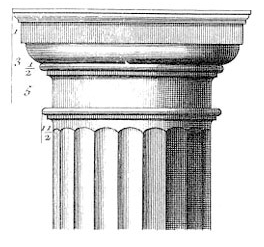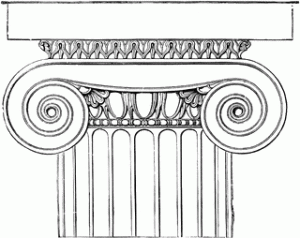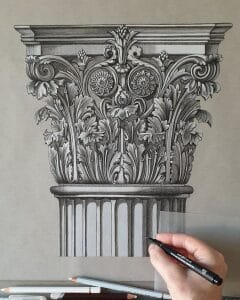
Ancient Greek and Roman Architectural Orders
The three ancient architectural orders
The Doric style :

The Doric Style:
The Doric order of Ancient Greek and Roman architectural orders is the oldest and most austere column style of antiquity. This type of column can be found on the Parthenon in Athens, Greece. The column has fluted sides with a smooth, rounded top called a capital, without a separate base.
It is characterized by massive and sturdy columns, a simple entablature, and an austere aesthetic.
Here are the main characteristics of the Doric order:
- Columns: Doric columns are short, stout, and lack a distinct base. They rest directly on the stylobate (platform) of the building. The columns have fluted shafts with shallow, wide flutes, typically numbering 20, and they are devoid of decorative capitals.
- Capital: The Doric capital is simple and robust. It consists of a smooth echinus (the upper part of the capital) and a square abacus, on which the entablature rests directly. The abacus is often slightly swollen on the sides.
- Entablature: The Doric entablature is composed of a massive, unornamented architrave that rests directly on the capitals of the columns. Above the architrave is a frieze divided into metopes (square panels) and triglyphs (rectangular blocks in relief). The triglyphs are regularly spaced and often decorated with three vertical grooves.
- Roof: Temples and buildings constructed in the Doric style are crowned by a steeply pitched roof. The roof is often supported by wooden elements, called triglyph beams, which rest on the columns of the peristyle.
The Ionic style :
The Ionic order is characterized by slender, fluted columns with a flared base, topped by an entablature consisting of an architrave, a sculpted frieze, and a cornice. The Ionic capital, shaped like coiled ram’s horns or volutes, is more complex and ornate. The column shaft is more slender (the ratio between the diameter of the base and the height of the column is 1/9). This style is often found in smaller buildings but also appears inside the Parthenon, showcasing a remarkable blend of styles within Ancient Greek and Roman architectural orders.
Here are the main characteristics of the Ionic order:
- Columns: Ionic columns are more slender and finer than Doric columns. They typically have a base composed of moldings and a fluted shaft with narrower and more numerous flutes compared to the Doric order.
- Capital: The Ionic capital is adorned with volutes, which are spiral scrolls located at each corner. The volutes give a sense of lightness and dynamism to the Ionic order.
- Entablature: The Ionic entablature consists of a smooth architrave, on which rests a sculpted frieze. The Ionic frieze is often decorated with motifs such as garlands, scrolls, or mythological figures. Above the frieze is a cornice, sometimes adorned with dentils (small teeth-like decorations).
- Porticoes: The Ionic order is frequently used in the construction of porticoes, where Ionic columns create an open gallery. These porticoes can be used to frame building entrances or as standalone decorative elements.
The Corinthian style
The Corinthian style is the most ornate and the latest of the classical orders. The capital, adorned with vegetal motifs, evokes the shape of acanthus leaves (a Mediterranean plant with deeply cut leaves). The Greeks used it sparingly, but the Romans adopted it extensively. It is employed for less imposing, more precious buildings within Ancient Greek and Roman architectural orders.
It is distinguished by its elegance, ornamental richness, and specific capitals.
Here are the main characteristics of the Corinthian order:
- Columns: Corinthian columns are similar to Ionic columns in their slenderness but have finer and fewer flutes. They often feature a decorative base.
- [the_ad id=”1018″]
Capital: The Corinthian capital is the most distinctive feature of this order. It is adorned with acanthus leaves that curl and extend around a central bell. The acanthus leaves can be very detailed, giving the capital a vegetal appearance. - Entablature: The Corinthian entablature is similar to that of the Ionic order, with a smooth architrave, a sculpted frieze, and a cornice. However, the Corinthian frieze is generally more ornate and may feature floral motifs, garlands, or sculpted figures.
- Ornamental Details: The Corinthian style is often characterized by an abundance of ornamental details. In addition to the acanthus leaves on the capital, volutes and floral motifs are frequently found throughout the Corinthian order.
7 Steps to Master the Architectural Design Process: The Ultimate Guide
The Corinthian order represents sophistication and grandeur, embodying the pinnacle of ornamentation in classical Ancient Greek and Roman architectural orders.






